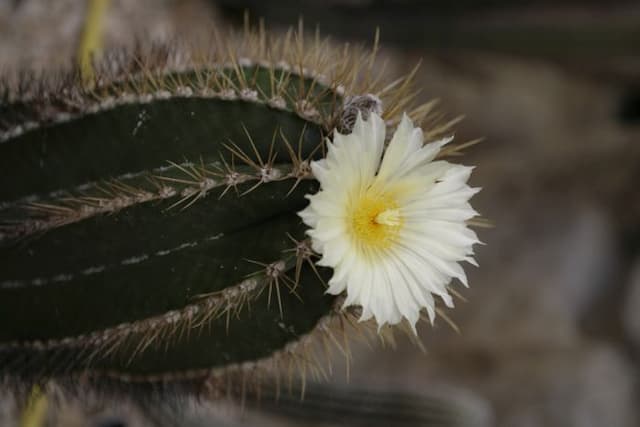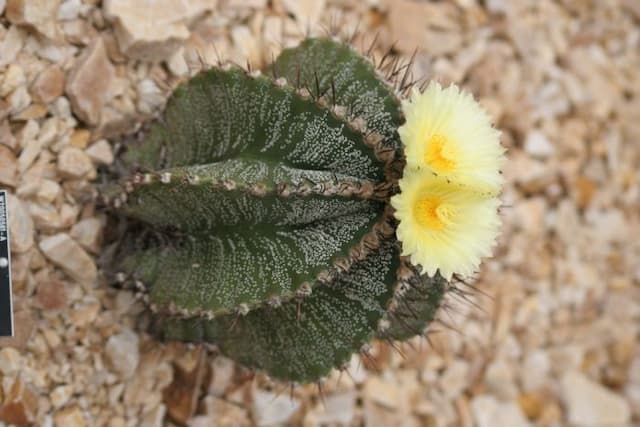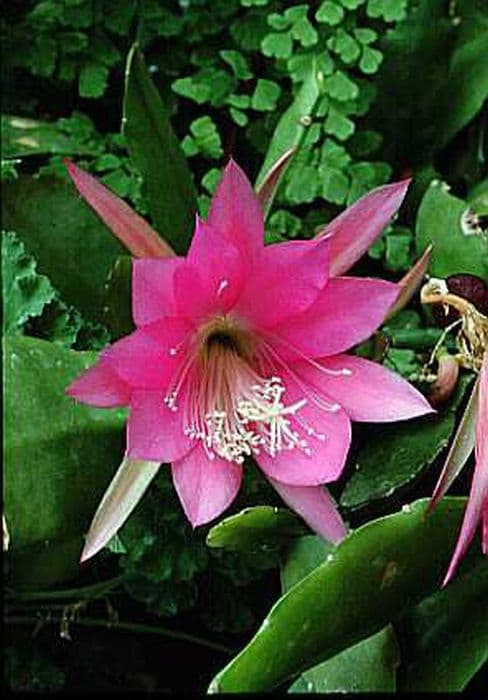Wright's hedgehog cactus Echinopsis backebergii subsp. wrightiana

ABOUT
Echinopsis backebergii subsp. wrightiana, commonly known as the Wright's cactus, is a visually striking succulent that captivates with its intricate form and vibrant blossoms. This cactus features a globular, spherical, or sometimes columnar body with prominent, evenly spaced ribs running vertically along its surface. Its skin is a green to blue-green, supporting numerous areoles from which sharp, needle-like spines emerge. These spines can vary in color from pale yellows to reds and browns, adding a layer of texture and protection to the plant. Most notably, the Wright's cactus is celebrated for its large, funnel-shaped flowers that burst forth in an array of brilliant hues. These blooms are particularly showy, often exhibiting vibrant colors such as deep reds, purples, oranges, or whites. The flowers provide a stark contrast to the spiny, rugged appearance of the cactus itself. The petals are soft and satiny, inviting a range of pollinators to visit. This plant exhibits a charming combination of formidable defenses and delicate beauty, making it a fascinating and attractive species for cactus enthusiasts and gardeners alike.
About this plant
 Names
NamesFamily
Cactaceae
Synonyms
Lobivia Belenensis, Lobivia Wrightiana
Common names
Echinopsis backebergii var. wrightiana, Trichocereus wrightianus, Echinopsis wrightiana, Lobivia wrightiana, Helianthocereus wrightianus.
 Toxicity
ToxicityTo humans
Echinopsis backebergii, commonly known as Backeberg's cactus, is not known to be toxic to humans when touched or ingested. There is no significant evidence to suggest that this cactus poses a risk of poisoning. However, as with all plants, some individuals may experience mild allergic reactions or skin irritation. Ingesting cactus spines can cause physical injury to the mouth, throat, and digestive tract. If any part of the plant is consumed, it is recommended to seek medical advice if symptoms or concerns arise.
To pets
Backeberg's cactus is also not known to be toxic to pets. There are no reports of pets being poisoned by ingesting parts of this cactus. However, it is important to note that the sharp spines can cause physical injuries to pets if they come into contact with or attempt to ingest them. Injuries might include punctures or abrasions to the mouth, paws, or digestive tract. If a pet ingests the spines or shows signs of distress after contact with the plant, it is advisable to consult a veterinarian.
 Characteristics
CharacteristicsLife cycle
Perennials
Foliage type
Evergreen
Color of leaves
Green
Flower color
Pink
Height
1 foot (0.3 meters)
Spread
2 feet (0.6 meters)
Plant type
Cactus
Hardiness zones
9
Native area
Bolivia
Benefits
 General Benefits
General Benefits- Ornamental value: Echinopsis backebergii subsp. wrightiana, commonly known as Backeberg's Cactus, is prized for its attractive spiny appearance and colorful flowers, making it a popular choice for ornamental displays in gardens and as a houseplant.
- Drought tolerance: Backeberg's Cactus is adapted to arid environments, requiring minimal watering and care, which is beneficial in regions with water scarcity and for gardeners seeking low-maintenance plants.
- Adaptability: This cactus can thrive in a variety of soil types, as long as they are well-draining, which allows for flexible planting options in different garden conditions.
- Wildlife support: The flowers of Backeberg's Cactus provide nectar for pollinators such as bees and hummingbirds, supporting local ecosystems.
- Educational interest: Backeberg's Cactus can serve as an educational tool for teaching about plant adaptations, desert ecosystems, and the diversity of cacti.
- Longevity: Being a slow-growing plant, Backeberg's Cactus can live for many decades, offering long-term enjoyment for growers.
 Medical Properties
Medical PropertiesThis plant is not used for medical purposes.
 Air-purifying Qualities
Air-purifying QualitiesThis plant is not specifically known for air purifying qualities.
 Other Uses
Other Uses- Echinopsis wrightiana, or Sea Urchin Cactus, can be used as a grafted base for more delicate or slower-growing cactus species, facilitating their growth by providing a hardier root system.
- The striking appearance of the Sea Urchin Cactus makes it ideal for inclusion in rock gardens or xeriscapes, adding an exotic touch to drought-tolerant landscaping designs.
- Due to its compact size, the Sea Urchin Cactus is suitable for indoor container gardens, where it adds a low-maintenance, sculptural element to the decor.
- The resilient nature of the Sea Urchin Cactus enables it to be used in educational settings, such as schools, to teach students about plant adaptations in arid environments.
- These cacti are often featured in botanical art and photography, serving as subjects that offer striking geometrical shapes and textures.
- Its flowers provide a valuable nectar source for pollinators like bees and hummingbirds in its native habitat, enhancing local biodiversity.
- In cultural events or local festivals in its native range, the Sea Urchin Cactus might be used symbolically or decoratively to celebrate natural heritage.
- The cactus can be cultivated for use as natural fencing in arid regions, as its spiny exterior can deter unwanted animals and foot traffic.
- During festive occasions, the Sea Urchin Cactus can be decorated with lights or ornaments to serve as a living, sustainable alternative to traditional decorations.
- Its aesthetic value and ease of care make it a popular choice for thematic gardens, such as those designed with a desert or southwestern United States theme.
Interesting Facts
 Feng Shui
Feng ShuiThe Lobivia is not used in Feng Shui practice.
 Zodiac Sign Compitability
Zodiac Sign CompitabilityThe Lobivia is not used in astrology practice.
 Plant Symbolism
Plant Symbolism- Resilience: Echinopsis backebergii subsp. wrightiana, commonly known as Lobivia, is a cactus that thrives in harsh, arid environments. Its ability to survive and bloom in difficult conditions symbolizes resilience and the capacity to endure challenges.
- Protection: The spines of the Lobivia cactus serve as a natural defense mechanism, representing protection and the need to guard oneself against external threats.
- Adaptability: As a plant that can adapt to extreme temperatures and scarce water supplies, Lobivia symbolizes the ability to adjust to changing circumstances and maintain growth.
- Beauty in austerity: Despite its rugged appearance, the Lobivia cactus produces beautiful, vibrant flowers, symbolizing the idea that beauty can flourish even in the most unlikely or austere places.
- Patience: Lobivia, like many cacti, takes time to grow and bloom. This slow growth process represents patience and the understanding that some things cannot be rushed.
 Water
WaterFor the Lobivia wrightiana, a native desert cactus, it is essential to water sparingly, mimicking its natural arid environment. During its active growth period in spring and summer, water the Lobivia wrightiana every 7-10 days, providing enough water to soak the soil and then allowing it to dry out completely between waterings. Use approximately 8-10 ounces of water for a small 4-inch pot, adjusting the amount for larger pots. In winter, reduce watering to once a month or less, depending on the humidity and temperature, to prevent root rot.
 Light
LightLobivia wrightiana thrives best in full sun to partial shade conditions. The ideal spot for this cactus is a location where it receives direct sunlight for at least 4-6 hours every day. If grown indoors, a sunny windowsill or a south-facing window would provide the right amount of light. It can tolerate some light shade, especially in the hottest parts of the day, to prevent sunburn.
 Temperature
TemperatureLobivia wrightiana prefers temperatures that range from 50°F to 85°F for optimal growth, reflecting its desert heritage. It can tolerate a minimum temperature of about 40°F, but exposure to frost or prolonged periods below this point can be detrimental. During the hot summer months, it can handle high temperatures as long as appropriate watering is maintained.
 Pruning
PruningPruning is not a routine requirement for the Lobivia wrightiana. However, any dead or damaged spines or flowers can be gently removed to maintain the plant's appearance and health. The best time for any necessary pruning is in the spring, right before the growth period begins. This plant doesn't often outgrow its pot or space, so significant pruning for size control generally isn't necessary.
 Cleaning
CleaningAs needed
 Soil
SoilThe best soil mix for the Lobivia (Echinopsis backebergii subsp. wrightiana) is a well-draining cactus mix consisting of regular potting soil, coarse sand, and perlite or pumice in equal parts. The soil pH should be slightly acidic to neutral, ideally ranging between 6.0 and 7.5.
 Repotting
RepottingLobivia (Echinopsis backebergii subsp. wrightiana) should generally be repotted every two to three years or when the cactus has outgrown its container. Repotting is best done during the warmer growing season.
 Humidity & Misting
Humidity & MistingLobivia (Echinopsis backebergii subsp. wrightiana) prefers low to moderate humidity levels and can tolerate dry air, characteristic of arid environments where humidity is typically below 50%.
 Suitable locations
Suitable locationsIndoor
Provide bright light, well-draining soil, low humidity.
Outdoor
Plant in sunny spot, protect from extreme cold.
Hardiness zone
9-11 USDA
 Life cycle
Life cycleEchinopsis backebergii subsp. wrightiana, commonly known as Lobivia backebergii, begins its life cycle as a small, round seed which, when sown in well-draining soil and provided with warmth, moisture and light, will germinate and sprout a tiny cactus seedling. This young cactus grows slowly, developing a spherical to short cylindrical stem with ribs lined with areoles that produce spines. After several years, the mature Lobivia backebergii reaches flowering maturity and produces vibrant funnel-shaped flowers, often in shades of red, orange, or yellow, which bloom during the day and close at night. The flowers are pollinated by insects, birds, or bats, leading to the formation of small, fleshy fruits that contain seeds, thus completing the reproductive cycle. As a perennial, Lobivia backebergii can continue to grow and produce flowers and fruits for many years. Offsets may also form at the base of the parent plant, contributing to new individuals and colony expansion.
 Propogation
PropogationPropogation time
Spring to Summer
For the Echinopsis backebergii subsp. wrightiana, commonly referred to as the Lobivia wrightiana cactus, propagation is commonly done through the process of seed sowing or by rooting offsets. The most popular method among enthusiasts is through offsets, which are small clones that grow at the base of the parent plant. To propagate using offsets, one would gently remove an offset from the main plant, preferably during the warm growing season when the cactus is actively growing. After removal, the offset should be allowed to dry for a few days to form a callous over the cut surface to prevent rot. Once calloused, the offset can be planted in a well-draining cactus potting mix. The soil should be kept slightly moist until the offset establishes roots. This process can take several weeks, and the new plants should not be exposed to intense sunlight during this period to avoid sunburn.









